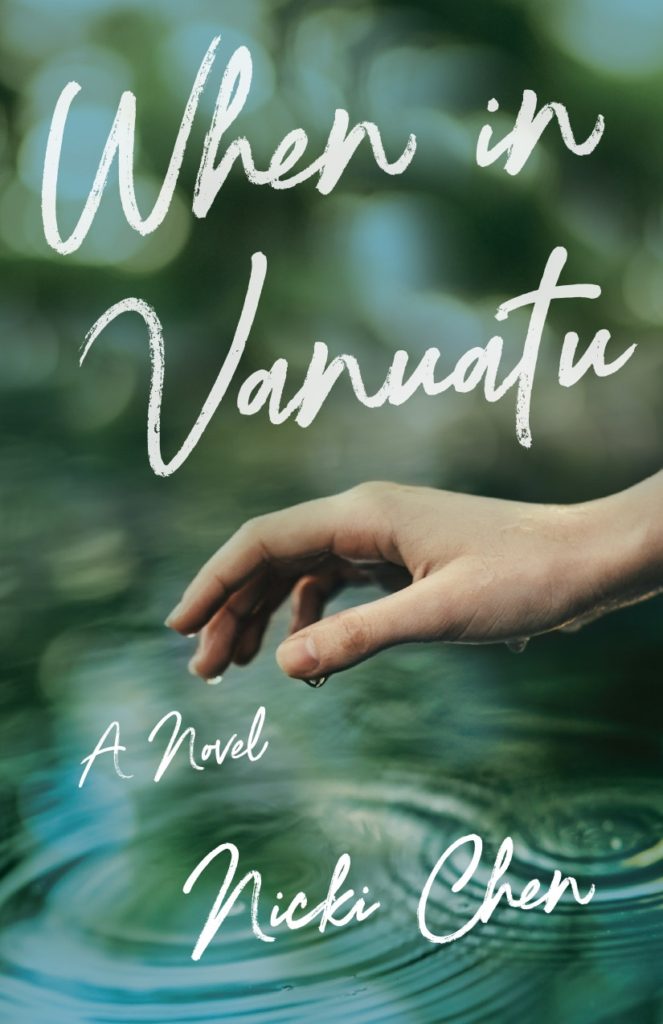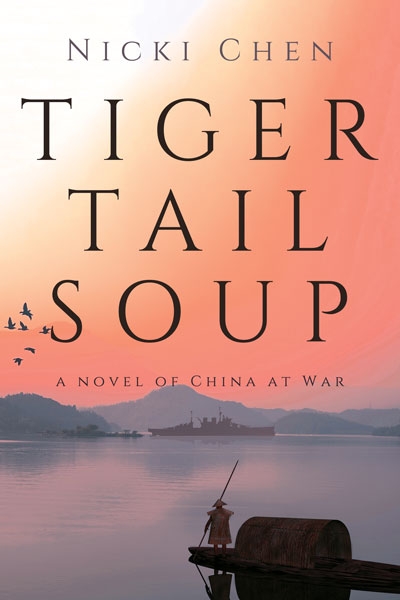
I like to eat as much as the next person. I put blueberries on my oatmeal and bananas in my breakfast smoothy. I eat soups and salads for lunch, stews and stir fries for dinner, yogurt, cookies, and chocolate candy for snacks.
But you wouldn’t exactly call me a foodie. That’s why I was surprised when quite a few readers commented on the food in my latest novel, When in Vanuatu. One reader was particularly enthusiastic: “The food … THE FOOD…” she wrote in her Amazon review, “oh my goodness, I need to eat this food now!”
My first thoughts were: Don’t all characters eat? And: What else are they going to do while they’re talking? On second thought, I supposed that one character could be polishing his rifle while the other peeks out the window watching the approaching FBI agents. Or one character could be knitting while the other smokes his pipe. But none of those are my characters.
In a novel by Robert Dugoni or Tana French (two of my favorite mystery writers) the characters might drink cold, stale coffee or warm beer and eat yesterday’s pizza or an old sandwich they left in the car. But those characters are in a hurry. They have big, dangerous cases to solve.
When in Vanuatu is different. My characters have time to talk over a meal or a snack. In an early scene in the novel, for example, the main character, Diana, meets friends at Dulcinea, a popular Spanish bakery in Manila. She opens the heavy glass door, leaving behind the stink of diesel, sweat, and roadside garbage and steps into a room smelling of toasted sugar, melted butter, and coffee. As the ladies talk, they sprinkle sugar on their freshly deep-fried churros, dip them in little cups of thick Spanish chocolate, and lick their lips.
Actually, now that I think of it, the characters in my novel did find many other opportunities to talk. Diana and her husband, Jay, talk while walking, waiting in the doctor’s office, driving a car, on a plane, in bed, in the shower, leaving church, and at the beach. But they’re expatriates in an international community. They live in the Philippines and then in Vanuatu, so they eat lots of delicious and interesting food.
They eat Filipino food like pancit, pork adobo, ginataang, and halo halo. At Jay’s office they order the daily special: tom yum soup, crystal noodles with prawns, Thai basil with chicken, finishing up with mango ice cream.
In Vanuatu, the papayas are plentiful, and the fish is always fresh. My characters eat at the beach, in Chinese restaurants and French restaurants and cafes. Diana even considers eating flying fox (fruit bat).
So, yes, I suppose there is a lot of good food in this novel. It’s not part of the plot, but everybody eats, even fictional characters. And in this book, it’s no coincidence that what they eat just happens to be tasty.








Nicki, the various meals sound wonderful and exotic – no wonder a reviewer mentioned it – in caps even! I’m smiling how you’d not particularly thought about the mention of the food but that it slipped in naturally into your writing!
It’s soon time for dinner … sadly nothing this grand or unusual! One day, perhaps!
Thank you, Annika. It was fun to include in my novel the food my characters ate. Living in Asia in an international community, the food is bound to be interesting and delicious.
Ah, I haven’t had halo halo in ages! Last time I was in the Philippines was 8 years ago already. Time flies! Last week a Filipino friend got married in Manila and if it wasn’t for this covid mess, I would have been there attending his wedding.
At least I get to have churros with hot chocolate here in Spain…
It’s been even longer since I’ve been in the Philippines. I’m sorry you missed your friend’s wedding. I wonder if they still release a pair of doves at Filipino wedding receptions.
The churros y chocolate were always excellent at Dulcinea, as were all their pastries. I haven’t found any bakery as good here.
Vanuatu is the only place I’ve ever had truly nice papaya. Is your book available on audio?
Papayas grow easily in Vanuatu. We had a yard full of papaya trees. Each of the workers who built the house grabbed a papaya as they walked to work, ate it for lunch, and threw the seeds around the yard. When we moved in, the yard was full of little trees. Before long, they were bearing fruit.
I haven’t had an audio book made yet. I’m thinking about it.
Please do – I walk to work listening to audiobooks and it would be so cool to be transported to Vanuatu whilst walking down Streatham High Street. But choose the actor with care – my husband has had a couple of books put onto audio and a good reader is vital
Thank you, Caroline, for the encouragement and advice.
I used to read Spenser mysteries and food played a big part in them. Seems like Spenser was forever eating with Suz or Hawk when he realized something. I wonder if that was how it was with Robert Parker, the author?
Maybe Robert Parker ate alone in a restaurant, so for him, it was a quiet time of contemplation. I think of things in the shower.
Well, this was the wrong post to look at while hungry! I’m glad you captured something special here with the food. It makes me think about iconic shows like Seinfeld where the characters are always eating (it seems), folks notice this level of detail.
Okay, off to cook dinner! xo
I’m 20% through the book I’m reading, Carnegie’s Maid, and I don’t think she has eaten yet. She did smell the stew the cook was making when she walked through the kitchen, though. I hope you had a good dinner.
I loved the eating in the book. It made things more relaxed. So much better than grabbing a hot dog by the subway! 🙂
And so much better to eat in a nice restaurant. I’m looking forward to that.
I need to try the Filipino-fusion restaurant in Edmonds.
My characters always eat – preferably Italian.
Living or traveling in Italy, I’d think it would be impossible not to comment on the food.
That Filipino restaurant has the added benefit of good outdoor seating.
I enjoy knowing what characters are eating . . . and am pleased when an author (like you) doesn’t have them talking over the same old beverage.
I recall reading books where the beverage of choice (tea, hot chocolate, beer, or coffee) was poured umpteen times during the course of 300 pages. BORING! \
Keep mixing it up, Nicki!
My own eating and drinking habits have become a little bit boring during the pandemic. Especially drinking. I used to drink a variety of teas. Lately I’ve become hooked on my morning coffee. I’m looking forward to Christmas, though. Everyone else is doing the cooking and baking. It should be good.
Luckily, when I’m writing, I remember all the good things I’ve eaten before.
I loved all the interesting foods you introduced me to in “When In Vanuatu,” Nicki. What a nice surprise to see our old writers’ group at the top of this page!
I needed a good opening picture, Maureen. Didn’t we all look great?!
Like old home week. Merienda and pancit bring back memories. But the Ube ice cream not so much!
Ube is so beautiful, but it’s too starchy for my taste. I usually ordered mango or buko ice cream on my halo halo especial.
On my first shopping trip in Manila, Eugene’s Aunt Kitty took me to Makati Supermarket and bought me a half gallon of sweet corn ice cream. Also not my favorite.
There are some books that just make you want to eat. I once had a book club where we rotated hosting and the hostess always tried to get thematic food, but it didn’t always work out well.
Your book would be perfect for it, of course. (Except for the fruit bat.)
I recently visited a couple of book clubs that served dinner before discussing my book. They didn’t think to theme the food, but everything they served was delicious. I don’t think they always serve big meals. Book clubs that just serve drinks and snacks probably last longer. We had a bunko group for a while that rotated houses for lunch. The lunches were always spectacular and fun. Eventually too many people got tired of all the effort of entertaining.
You always do a wonderful job sharing the food your charcaters eat. Makes me hungry!
Thank you, Paddy. I was thinking this morning not about food but about characters. Getting into their lives and heads is harder.
I love Filipino food. I’ve had just about all of the dishes you mentioned because of my Filipino friends who are great cooks! So I’m not surprised that people commented on the food. I also love to read about great food in books. Agatha Christie’s Christmas stories are filled with the mention of food. And Dickens doesn’t skimp on the food either.
Good. I’m glad you mentioned Dickens and Agatha Christie.
You’re lucky to have Filipino friends. Not only do Filipinos like to cook and eat, they like to get together and have parties. One year after we moved back to the US, my husband and I joined a Knights of Columbus caroling group. Everyone else was Filipino, and they all could sing. We practiced for a couple of weeks. Then we went caroling to the houses of other Filipinos who were expecting us. Each family invited us in and served us food. It was lots of fun but very filling.
I think it’s partially that your characters eat a variety of delicious foods but also that you have a talent for describing the experience of tasting them!
Thank you, Catherine. No matter how many important and interesting things we have going on in our lives, we still have to eat two or three times every day, and the food has to be palatable enough that we’ll feel like eating it. So it’s not surprising that we care about food. When we had maids, I used to write out recipes and weekly menus for the cook. Choosing what to eat sometimes seems harder than cooking it.